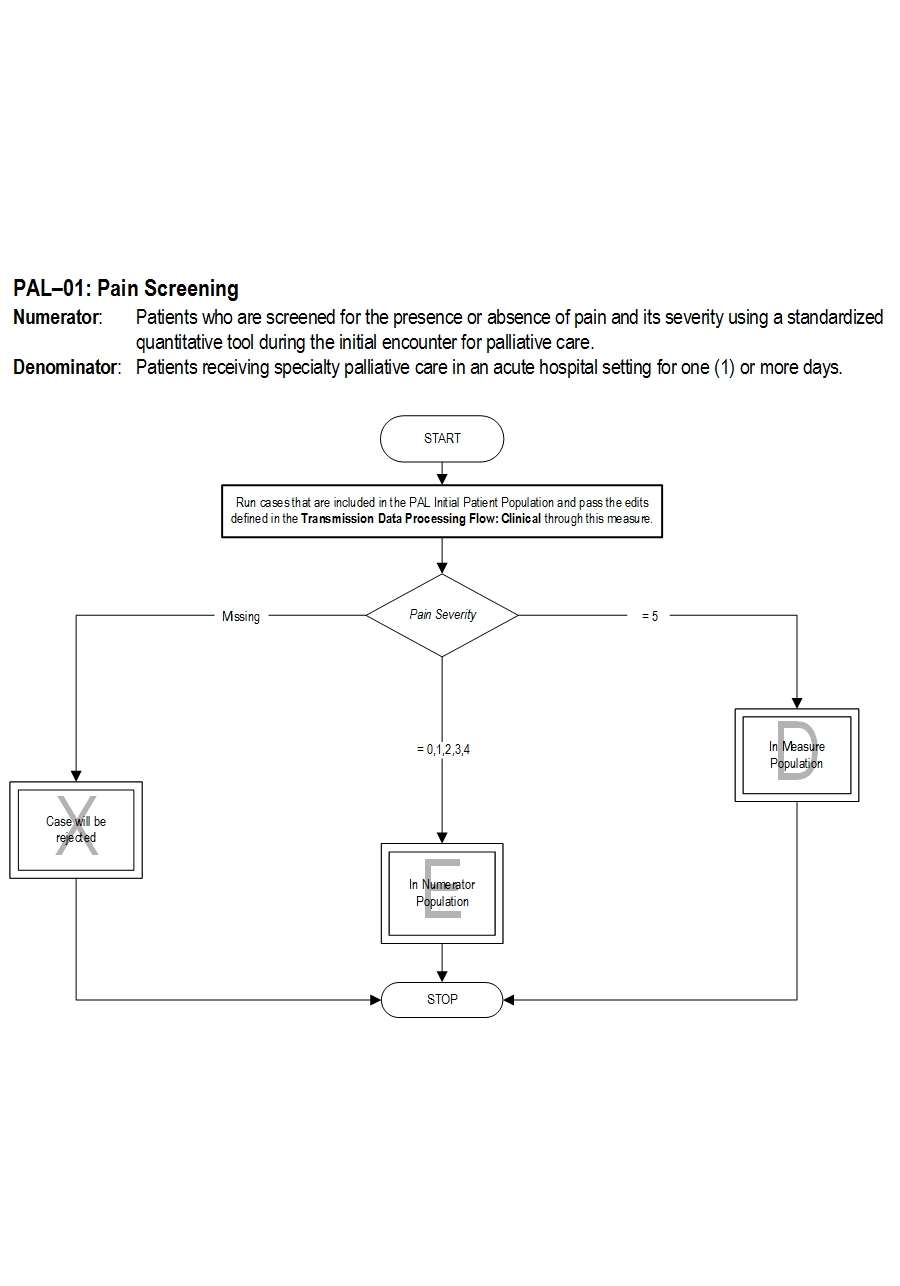Release Notes:
Measure Information Form
Version 2018A
Measure Information Form
Version 2018A
Measure Information Form
The National Consensus Project for Quality Palliative Care (2013) guidelines recommend that the interdisciplinary team assesses and manages pain in a safe and timely manner to a level acceptable to the patient or surrogate and that symptom assessment, treatment, side effect and treatment outcome information should be recorded in the medical record.
Type of Measure: Process Improvement Noted As: Increase in the rate Numerator Statement: Patients who are screened for the presence or absence of pain and its severity using a standardized quantitative tool during the initial encounter for palliative care.
Risk Adjustment: No.
Data Collection Approach: Retrospective data sources for required data elements include administrative/billing data and medical records. Some hospitals may prefer to gather data concurrently by identifying patients in the population of interest. This approach provides opportunities for improvement at the point of care/service. However, complete documentation includes the principal or other ICD-10CM/PCS diagnosis and procedure codes, which require retrospective data entry.
Data Accuracy: Variation may exist in the assignment of ICD-10CM/PCS codes; therefore, coding practices may require evaluation to ensure consistency.
Measure Analysis Suggestions: None
Sampling: Yes. Please refer to the measure set specific sampling requirements and for additional information see the Population and Sampling Specifications Section.
Data Reported As: Aggregate rate generated from count data reported as a proportion.
Selected References: Included Populations: Not applicable Excluded Populations: None Data Elements:Denominator Statement: Patients receiving specialty palliative care in an acute hospital setting for one (1) or more days
Included Populations: Excluded Populations:Data Elements:
- Palliative care program length of stay less than 1 day
- CMS Hospice Item Set, http://www.cms.gov/Medicare/Quality-Initiatives-Patient-Assessment-Instruments/Hospice-Quality-Reporting/Hospice-Item-Set-HIS.html
- Deandria S, Montanri M, Moja L et al. Prevalence of undertreatment of cancer pain: a review of published literature. Ann Oncol 2008; 19:1985-91.
- Erdek MA, Pronovost PA. Improving assessment and treatment of pain in the critically ill. Int J Qual Health Care 2004; 16:59-64.
- Gordon DB, Dahl JL, Miaskowski C et al. American Pain Society recommendations for improving the quality of acute and cancer pain management. Arch Intern Med 2005; 165:1574-1580.
- Gordon DB, Pelliano TA, Miaskowski C et al. A 10-year review of quality improvement monitoring in pain management: recommendations for standardized outcome measures. Pain Manage Nurs 2002; 4:116-130.
- Measuring What Matters, http://aahpm.org/quality/measuring-what-matters
- Mularski R, White-Chu F, Overbay D et al. Measuring pain as the 5th vital sign does not improve quality of pain management. J Gen Intern Med 2006; 6:607-612.
- National Consensus Project for Quality Palliative Care. Clinical Practice Guidelines for Quality Palliative Care. 3rd ed. Pittsburgh, PA: Author; 2013. http://www.nationalconsensusproject.org/NCP_Clinical_Practice_Guidelines_3rd_Edition.pdf
- PEACE Hospice and Palliative Care Quality Measures, http://www.med.unc.edu/pcare/resources/PEACE-Quality-Measures
- Reynolds K, Henderson M, Schulman A, Hanson LC. Needs of the dying in nursing homes. J Pall Med 2002; 5:895-901.
- Wells N, Pasero C, Applications/LocalApps.McCaffery M. Improving the Quality of Care through Pain Assessment and Management. In: Hughes RG, editor. Patient Safety and Quality: An Evidence-Based Handbook for Nurses. Rockville (MD): Agency for Healthcare Research and Quality (US); 2008 Apr. Chapter 17.
American Academy of Hospice and Palliative Care (AAHPM) and Hospice and Palliative Nurses Association (HPNA) Measuring What Matters Project Top Ten Measures That Matter List
CMS Hospice Item Set
PEACE Hospice and Palliative Care Quality Measures Set Measure Algorithm:

| Related Topics |
Questions? Ask Question to Joint Commission staff
Copyright © 2018 by The Joint Commission.